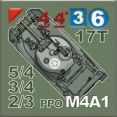Jonathan Palfrey
Posts: 535
Joined: 4/10/2004
From: Sant Pere de Ribes, Spain
Status: offline

|
As the program doesn't play well, correct strategy against the program may be somewhat different from correct strategy against a competent human player.
Playing against a human, the game is basically one in which the Union player tries to batter his way into a series of almost-invulnerable fortified cities.
The Union player needs to build a lot of ocean and river ships to destroy city fortifications wherever they can be reached by water. He will lose a lot of ships doing this and needs to be able to replace them quickly. But as a first priority, he must blockade the South by patrolling every Confederate port with at least six ships each. This cuts Confederate supplies dramatically and is the easiest and most effective way to hurt the Confederacy. It's probably best not to lose ships attacking forts until you have the blockade in place. Increase your shipbuilding capacity; this is expensive, but needs to be done: even the Union has nothing like enough capacity at the start of the game.
Compared with the Union, the Confederacy is short of men and supplies -- especially after the blockade is in place. I know it's boring, but the Confederacy should try to fight almost every battle as the defender. There are occasional opportunities to benefit from attacking, but be very careful, because an attack can easily go wrong and lose men you can't afford to lose. Sit in fortified cities and let the Union player attack you. There's nothing else he can do.
If you lose a battle or your forts are destroyed, don't panic and order a retreat. Build more forts and sit tight. Units in a fortified city never seem to retreat unless they're ordered to do so.
I really don't know whether it's worth building a Confederate navy or not. It can certainly worry the Union player if you do, but if your ships just get sunk, as they probably will, they might end up looking like a waste of men and supplies. In a game I played, I found that a Confederate navy came in useful after European intervention, to join forces with the French/British navies, but if you never get European intervention this doesn't apply.
Ship as much cotton as you can before the Union blockade becomes effective. Try not to spend all the supplies you get that way: you'll have more need of them later.
At the start of the game, defend Beaufort and Norfolk (with divisions, not just garrisons) and preferably New Bern and Plymouth too. The other ports are a lower priority because a bug in the game may prevent the Union player from reaching them by sea (don't rely on this, though). Remember that you can lose the whole of Texas by leaving Sabine undefended; but it takes a while for Union ships to get to Sabine, even if they manage to bypass Beaufort on the way.
The Union player should invade Norfolk, Plymouth, New Bern, or Beaufort if his patrolling fleets find that they're undefended. Garrisons are invisible, but garrisons are very vulnerable as long as the invaders have some artillery with them. Unfortunately artillery is heavy and requires more ships to carry it; but you have some understrength artillery brigades at the start of the game that can be used. Trying to invade the more southern Confederate ports is risky because your fleet may decide of its own accord to land at Norfolk or Beaufort instead.
The Union player should take and hold Missouri and Kentucky early in the game, and defend each city in those states with a permanent division (use low-rated leaders for this duty). A garrison is not enough, for two reasons: garrisons sometimes vanish (a bug in the game), and garrisons are sometimes defeated by civilian revolts (a feature of the game). But a division, even of only one brigade, seems to be safe against both problems.
|
 Printable Version
Printable Version












 New Messages
New Messages No New Messages
No New Messages Hot Topic w/ New Messages
Hot Topic w/ New Messages Hot Topic w/o New Messages
Hot Topic w/o New Messages Locked w/ New Messages
Locked w/ New Messages Locked w/o New Messages
Locked w/o New Messages Post New Thread
Post New Thread